Report

Executive Summary
- Global healthcare PE exits rose to 126 in 2019, up from 112 in 2018. Disclosed deal value rose to $40.8 billion, from $31.6 billion in 2018, as the value of IPOs increased by 72%.
- The median holding period held steady at 4.3 years, in line with the lowest level since 2009.
- PE funds also made more quick flips and partial exits. The first quartile of holding periods declined from 3.6 years in 2014 to 3.0 years in 2019.
- Sponsor-to-sponsor transactions remained the highest share of exits, representing 53% in 2019.
This article is part of Bain’s 2020 Global Healthcare Private Equity and Corporate M&A Report. Explore the contents of the report here or download the PDF to read the full report.
Tracking historical norms, exit volume and value held relatively steady in 2019, following a spike in activity from 2012 to 2015 (see Figure 11). Exit volume rose slightly to 126 in 2019, up from 112 in 2018, while disclosed exit value increased to $40.8 billion, compared with $31.6 billion. A 72% increase in IPO exit values vs. 2018 helped drive the increase in exit value as several high-profile assets went public.
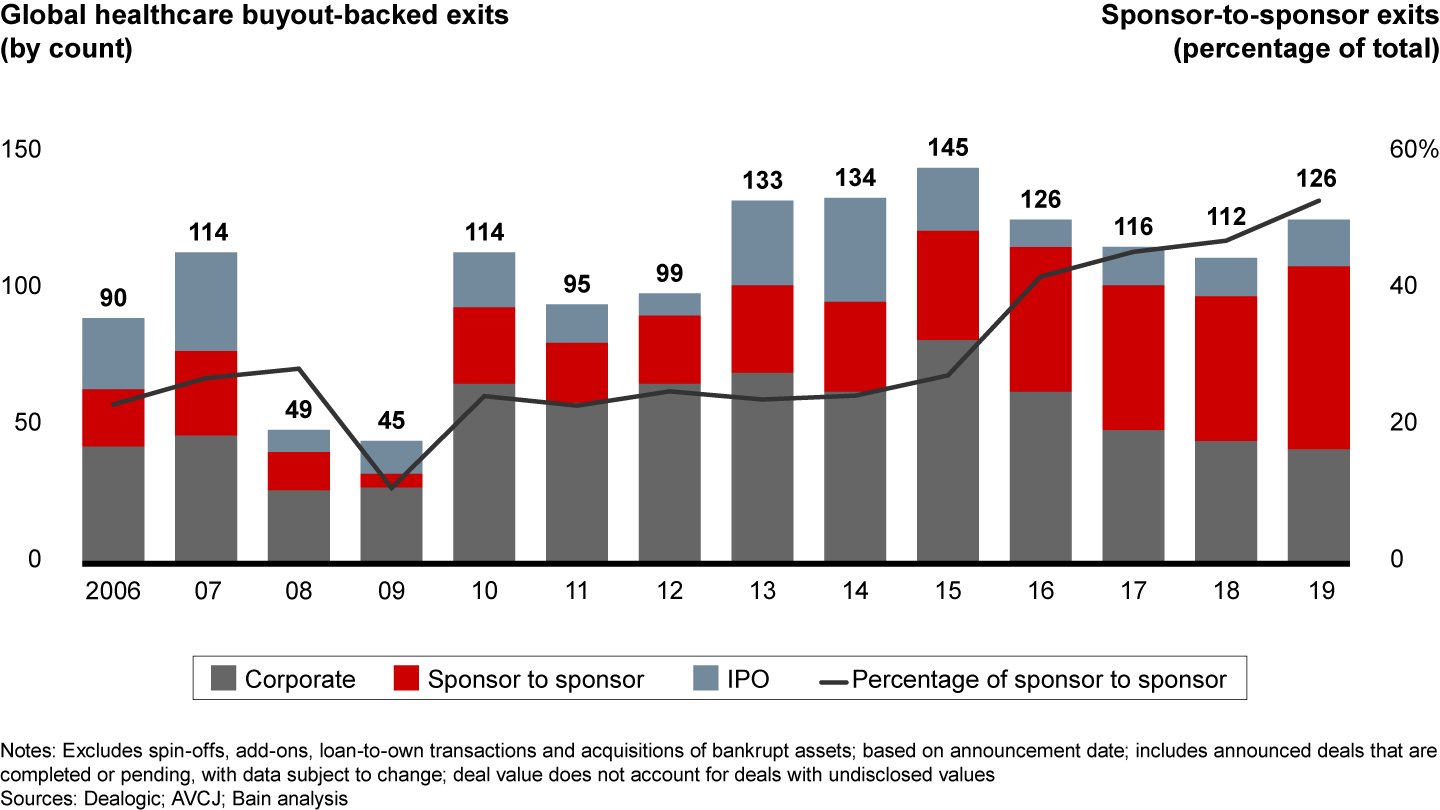
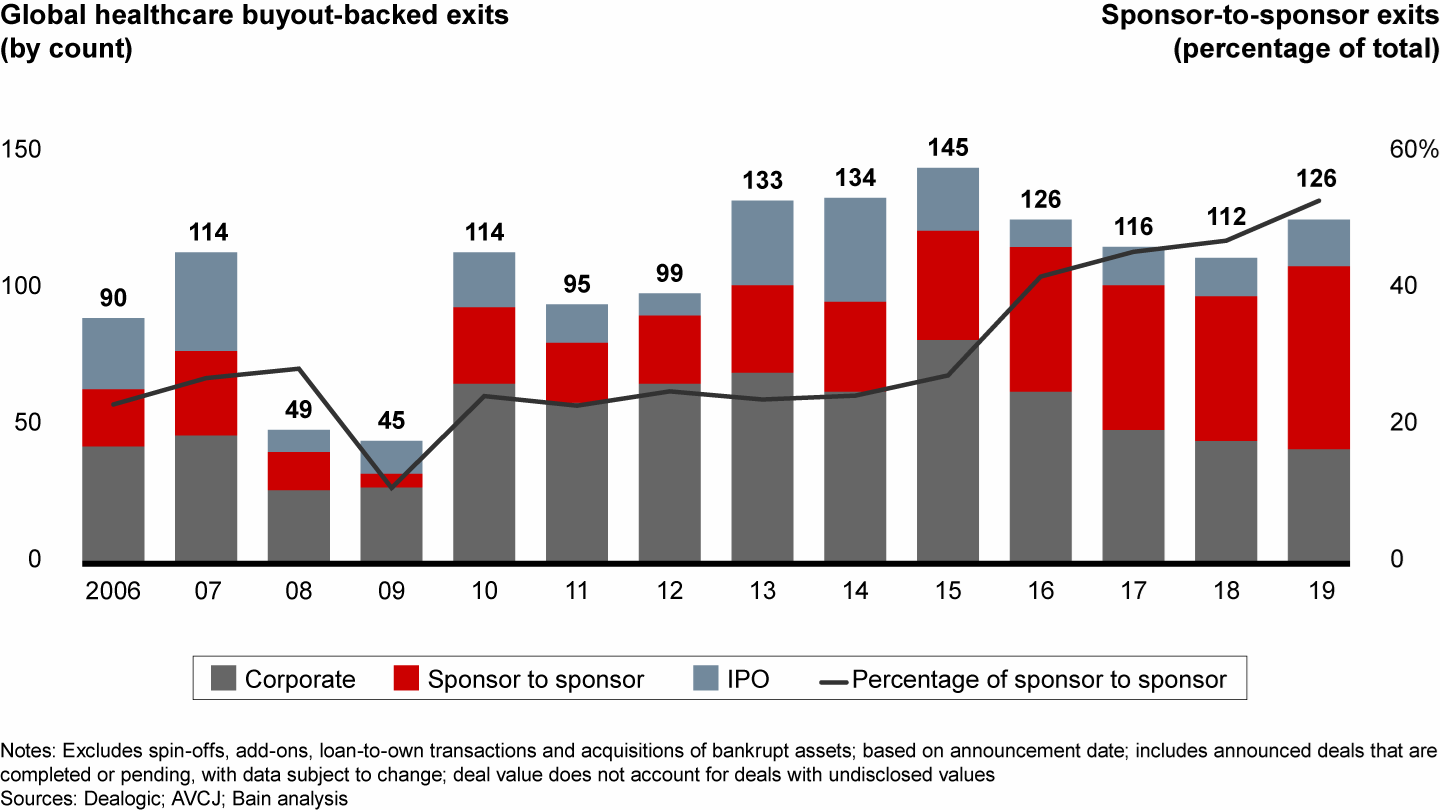
Sponsor-to-sponsor exits remained the most prominent channel at around 53% of all exits in 2019, a significant increase from earlier in the decade. This trend stems from the overhang of capital dedicated to healthcare, as well as the industry’s strong returns and resilience at any stage of the economic cycle.
The share of corporate deals declined slightly to 33% from 40% in 2018. Corporate buyers were particularly interested in biopharma and medtech, as industry leaders bought smaller companies with novel R&D assets or medical devices.
IPOs, meanwhile, were most common in biopharma, particularly with smaller-stage companies. These companies often come with regulatory approval risk, and the fan of outcomes tends to be too wide for the risk tolerance of PE sponsors.
Flip it quickly, but keep a piece of it
After a time of longer holding periods following the recession, typical holding periods have returned to the standard three to five years. The median holding period across all exits held steady at 4.3 years in 2019, compared with 4.1 years in 2018, which was the lowest since 2009 (see Figure 12). This indicates investors have offloaded the tail of their pre-recession assets, returning portfolios to a healthier position.
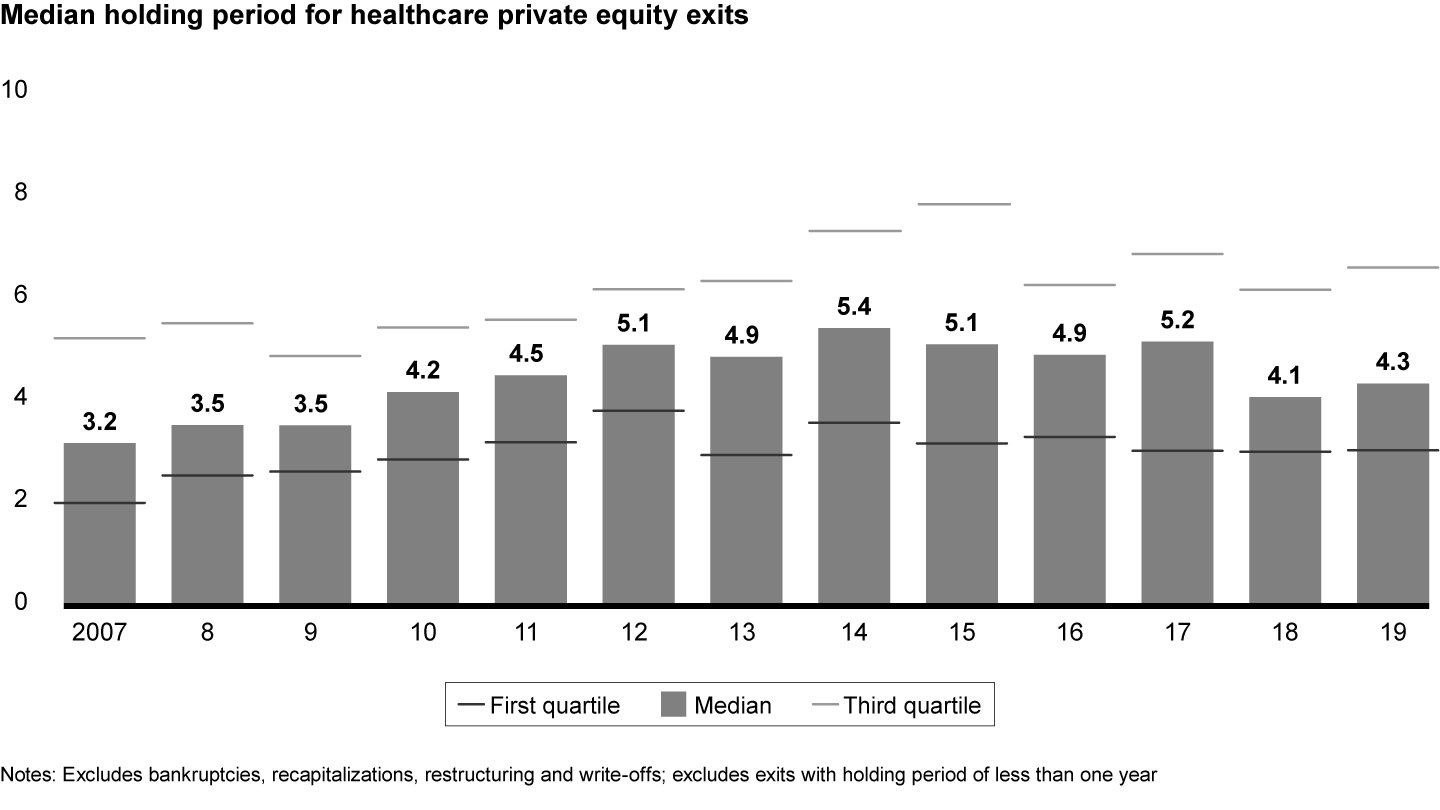
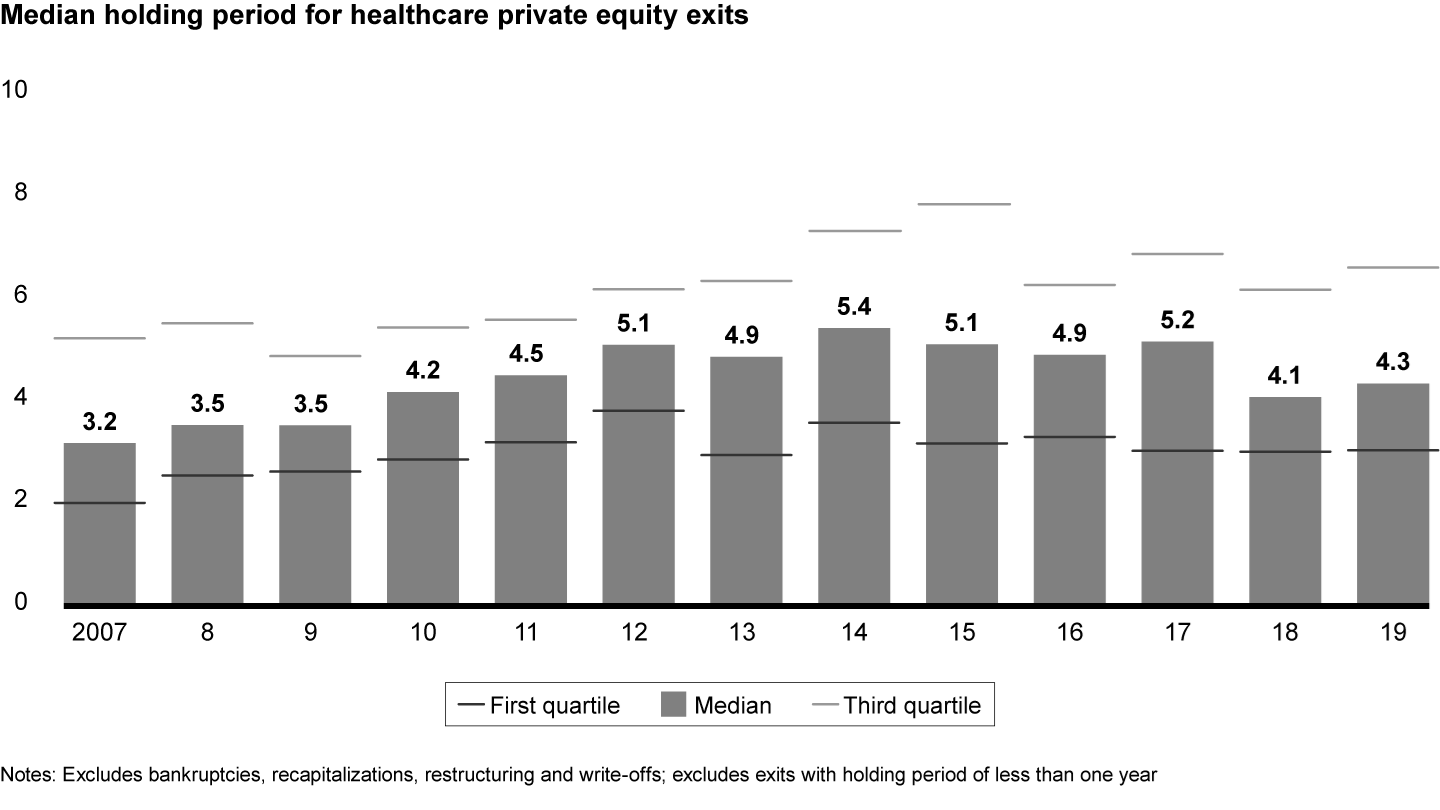
We would also note the increasing popularity of quick flips, or assets held for less than three years. The first quartile of holding periods has declined from 3.6 years in 2014 to 3.0 years in 2019. As private capital deployed to healthcare piles up faster than the number of assets, sponsors have more chances to resell high-quality assets. An example was EQT’s exit after only two years from Clinical Innovations, a medical device company focused on labor and delivery and neonatal intensive care, to Patricia Industries-owned Laborie Medical Technologies, for $525 million.
With quick flips, we also see sellers sometimes retaining a minority stake in the asset, keeping some long-term upside potential while also locking in high returns for current funds. For example, Bain Capital sold Waystar to EQT and CPPIB after only three years, but retained minority investment as a testament to the growth trajectory and long-term value it perceived in the business.
Biopharma and medtech exits continue to differ from those in the provider and payer sectors. In biopharma and medtech, sales to corporates, or IPOs, are more prevalent. By contrast, provider and payer sectors both feature a high concentration of sponsor-to-sponsor deals, with some corporate activity (see Figure 13).
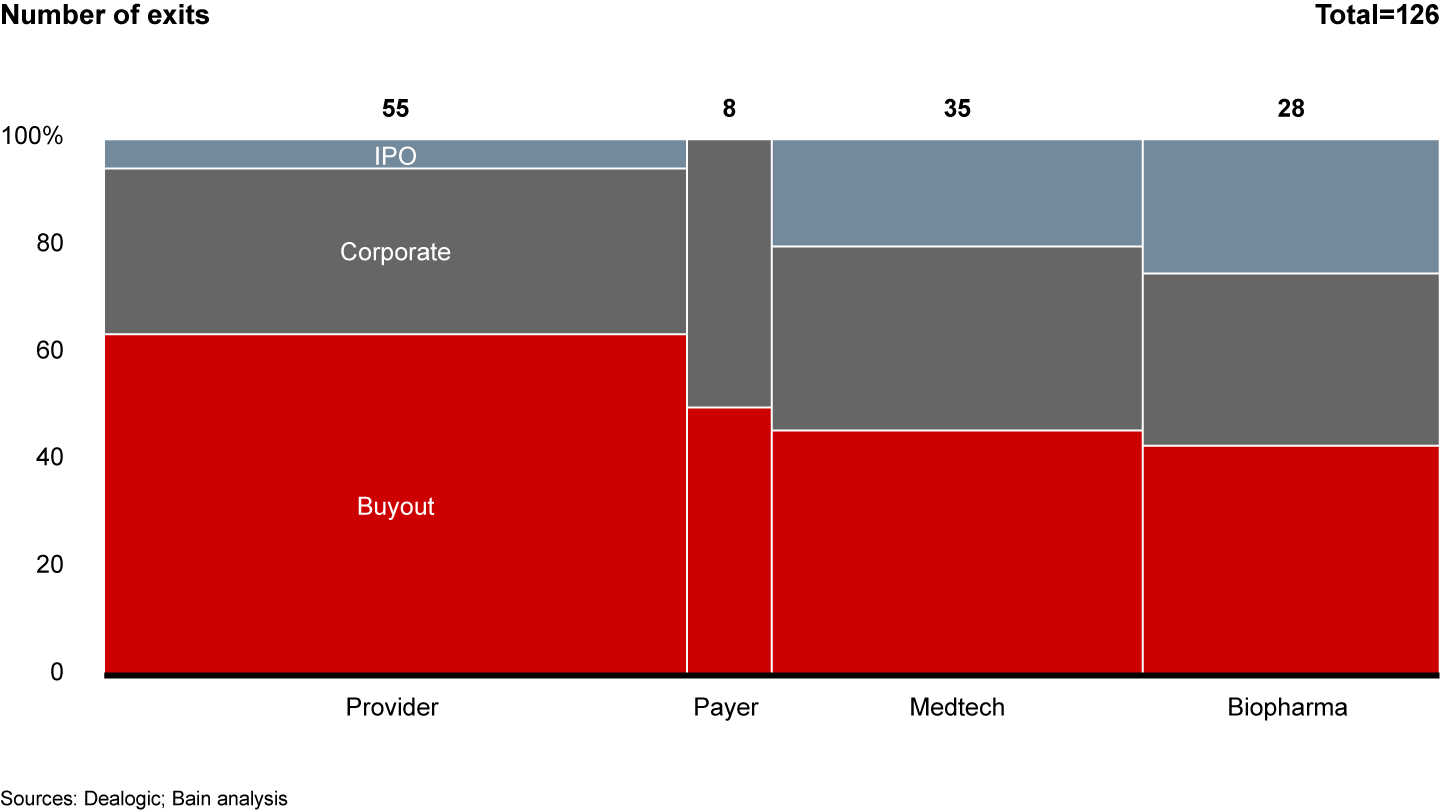
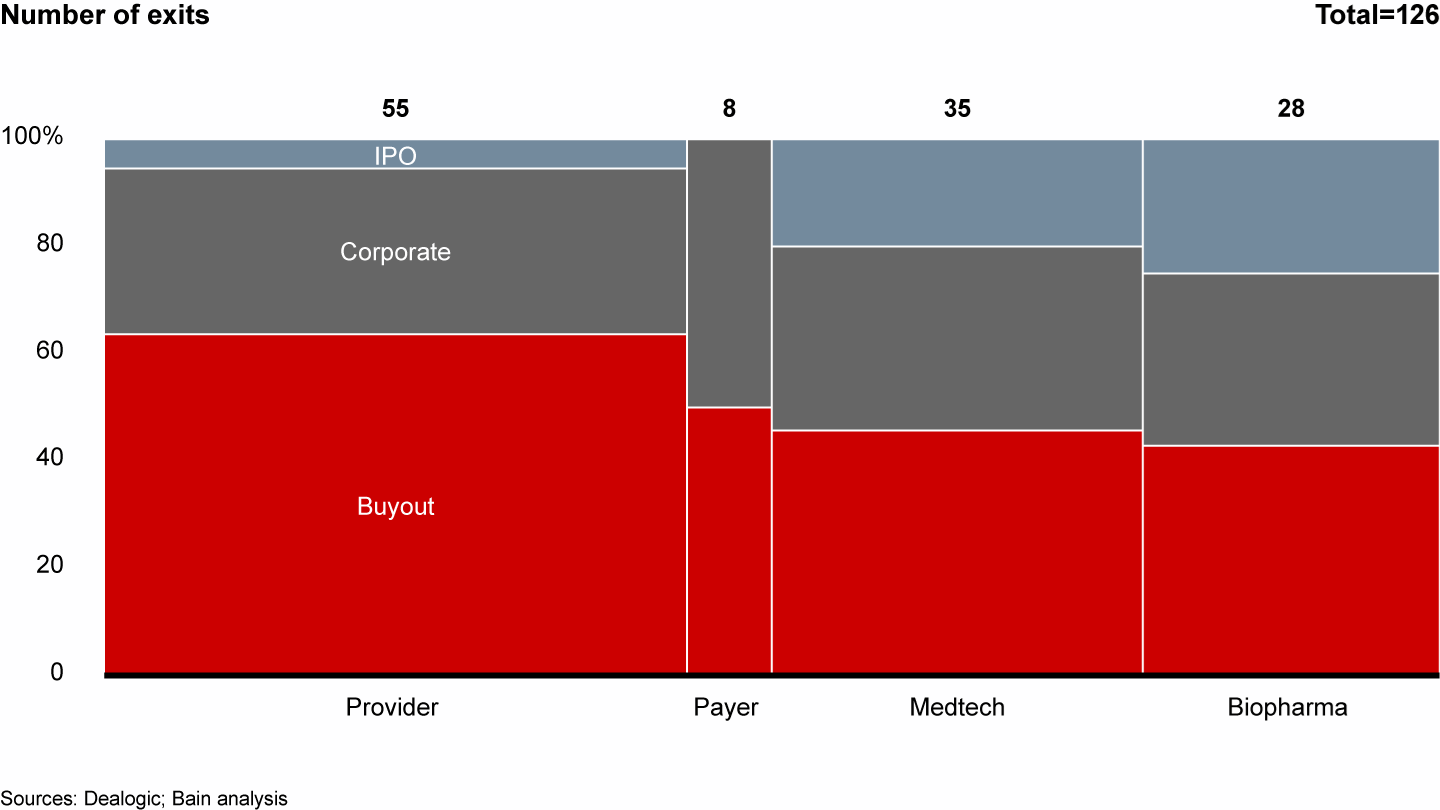
Providers and related services often stay with PE funds
Sponsor-to-sponsor exits prevail in the provider and related services sector. Few large corporates are natural acquirers for multigeography assets. With a long record of buy-and-build strategies, sponsors have a proven value creation plan they can rely on to underwrite deal theses.
For example, JAB Holding bought National Veterinary Associates from Ares Management and OMERS. In one of the largest vision services deal to date, Atlas Partners and CDPQ sold Capital Vision Services (operating as MyEyeDr.), a provider of full-service vision care services, to Goldman Sachs for $2.7 billion.
Payer and related services command high prices
While there were relatively few payer exits in 2019, they represented 15% of disclosed deal value because they commanded high prices. Just as in the provider sector, many exits go to sponsors; however, in the payer sector, an equal share of exits also go to corporates.
Large corporates used acquisitions to diversify their revenue, build scale in adjacent non-risk-bearing revenue streams, and create efficiencies in their current business model. Equian, a payment integrity service between payers and providers, was acquired by UnitedHealth Group for $3.2 billion, and Anthem acquired Beacon Health Options, a provider of behavioral health services, from Bain Capital for an undisclosed amount.
On the other hand, large PE investments here have focused on financing flows, reducing the cost of self-funded employee plans and supporting Medicare Advantage. For instance, New Mountain Capital exited Convey Health Solutions, a payer services company that offers administrative software for government-sponsored health plans and administration of supplemental benefits for Medicare Advantage plans, in a sale to TPG.
Medtech and related services: Corporates’ incentives to outbid private equity in devices
The medtech sector claims a high share of corporate exits because large corporates have structural incentives to outbid PE funds in key segments like pure medtech devices, whereas financial sponsors often can compete well for outsourced and noncore functions.
Corporate buyers want to build category leadership in specific therapeutic areas as well as expand the number of therapeutic areas covered by their portfolios, to leverage existing call points and manufacturing. In an environment where shareholders reward revenue growth over profit margin expansion, corporate buyers remain motivated to use M&A as a lever to raise revenues.
While these conditions make it difficult for sponsors to compete for deals, they also give sponsors an exit route of selling their assets to corporates. In the largest healthcare exit of 2019, Apax Partners, CPPIB and PSP Investments sold Acelity, a medical equipment and supplies manufacturer, to 3M for $6.7 billion. Another exit saw H.I.G. Capital, Morgenthaler, and Thomas, McNerney & Partners sell Vertiflex, the developer of a minimally invasive device used to treat lumbar spinal stenosis, to Boston Scientific for $465 million.
Medtech did not see much IPO activity during the year. One phenomenon that could make IPOs viable is the rise of consumer medtech. Clayton Dubilier & Rice and Kleiner Perkins, for instance, backed SmileDirectClub, an affordable direct-to-consumer dental aligners service, which raised $1.3 billion in an IPO.
Biopharma and related services: A high share of IPOs plus corporate acquisitions
The biopharma sector saw a high share of corporate acquirers, and also had the highest share of IPOs. As nascent biopharma firms come closer to starting clinical trials, they often go public to allow their venture investors to exit as well as prepare for the development and clinical trial costs associated with bringing a novel drug to market. In many cases, they prefer IPOs to adding private funds, because public equity tends to come at a lower cost of capital than private equity, and public investors typically get less involved in management decisions.
This is why KKR-backed BridgeBio Pharma, a pharmaceutical company specializing in gene therapy services, made an IPO for $348.5 million, and Bain Capital sold SpringWorks Therapeutics, a pharmaceutical company applying precision medicine to rare diseases and cancer, in an IPO for $162 million.
Outlook: Strong activity even if a downturn occurs
We expect to see sustained strong exit activity among buyout firms and corporates, with partial exits popular for sponsors seeking to get the best of both worlds by locking in quick gains while still retaining upside potential. Sponsors will also be looking for ways to change the profiles of companies for exit, including identifying hidden data assets and potential analytics offerings that can provide supplemental or game-changing revenue streams.
Assuming no downturn, holding periods should remain at their current levels. Yet even in the case of a recession, sponsor activity is likely to stay strong. PE funds and their LPs must continuously deploy capital, and healthcare has proved to be a relatively safe haven in a recessionary environment.
This article is part of Bain’s 2020 Global Healthcare Private Equity and Corporate M&A Report. Explore the contents of the report here or download the PDF to read the full report.